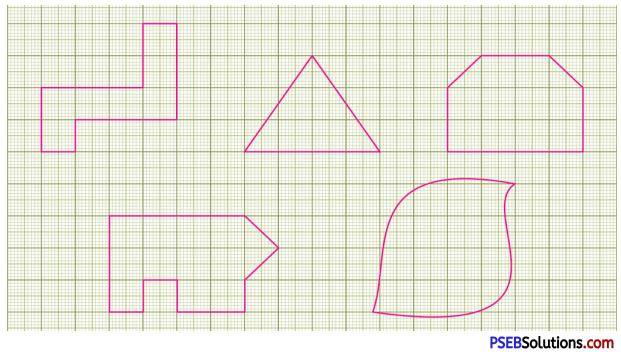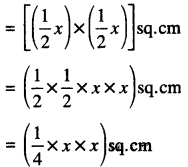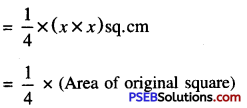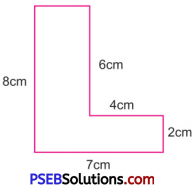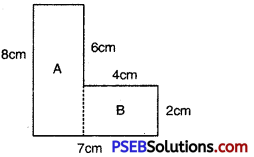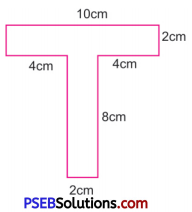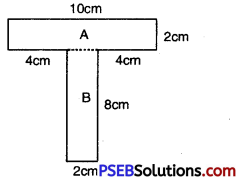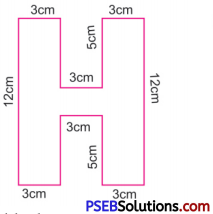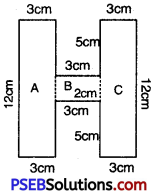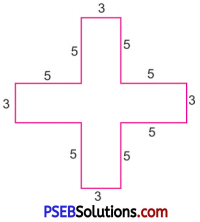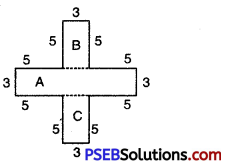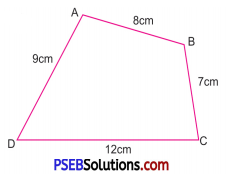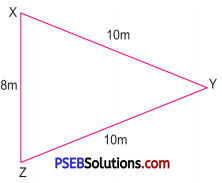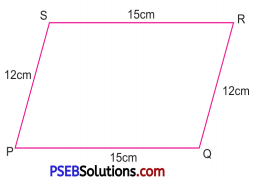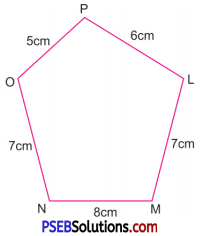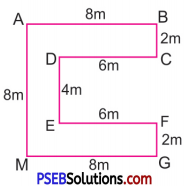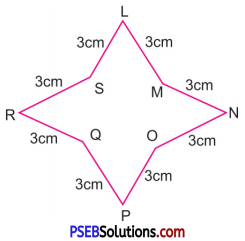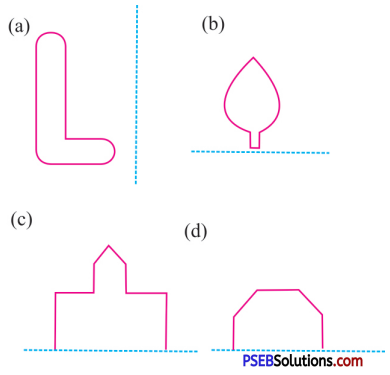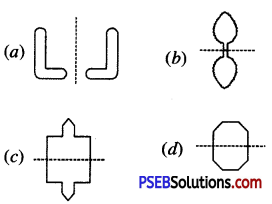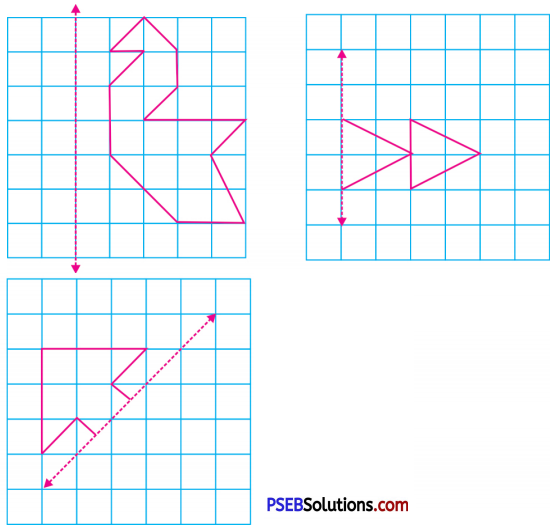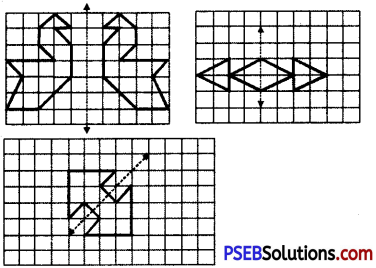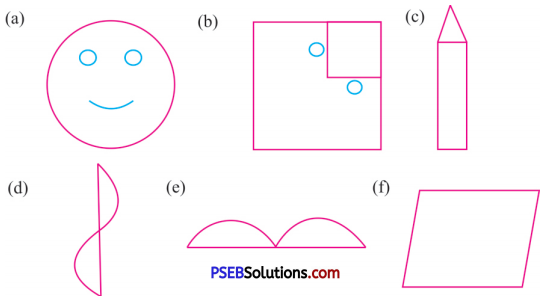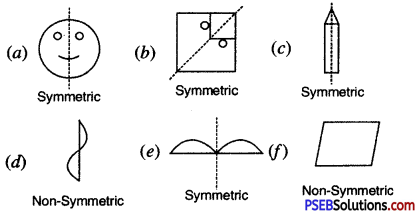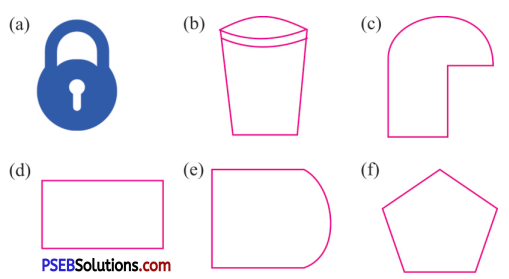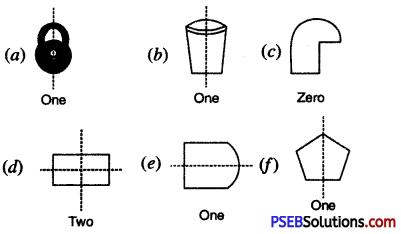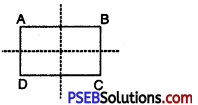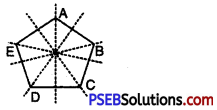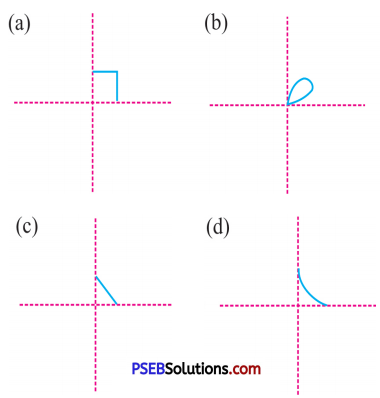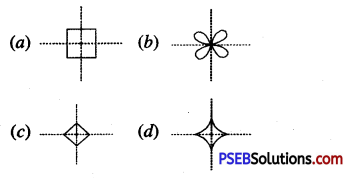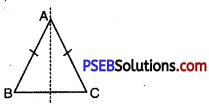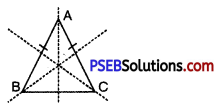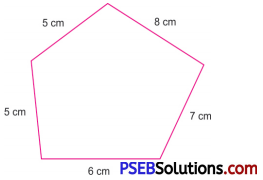Punjab State Board PSEB 6th Class Hindi Book Solutions Chapter 14 ज Textbook Exercise Questions and Answers.
PSEB Solutions for Class 6 Hindi Chapter 14 ज
Hindi Guide for Class 6 ज Textbook Questions and Answers
भाषा-बोध (प्रश्न)
1. शब्दों के अर्थ पाठ के आरम्भ में दिए जा चुके हैं।
सावन = श्रावण ( एक महीने का नाम)
शगुन = शुभ
प्रतीक = बताने वाला चिह्न
थिरकर = नाचना
सौगात = उपहार, भेंट
बौछार = झोंका
तपिश = गर्मी
सिमटना = सीमित रह जाना
वर्जित = मनाही
पखवाड़ा = पंद्रह दिन का समय
2. निम्नलिखित मुहावरों का अर्थ बताते हुए वाक्यों में प्रयुक्त करें
1. आँख मिचौली खेलना,
2. मन-मयूर नाच उठना।
उत्तर:
आँख मिचौली खेलना = लुका-छिपी-बादलों के कारण आज सूर्य आँख मिचौली खेल रहा है।
मन-मयूर नाच उठना = बहुत प्रसन्न होना-सालों के बाद भाई के विदेश से आने पर सुनीति का मन-मयूर नाच उठा।
3. विपरीतार्थक लिखें
1. आरम्भ = ………………….
2. सूखा = …………………..
3. शुक्ल पक्ष = ………………….
4. उदय = ………………..
5. गर्मी = …………………
6. विवाहित = ………………….
7. मिलाप = ………………..
उत्तर:
1. आरम्भ = अन्त
2. सूखा = गीला
3. शुक्ल पक्ष = कृष्ण पक्ष
4. उदय = अस्त
5. गर्मी = सर्दी
6. विवाहित = अविवाहित
7. मिलाप = विछोह
4. लिंग बदलें
1. मोर = …………………
2. नौजवान = …………………..
3. पुत्रवधू = …………………..
4. बुड्डा = ………………….
5. गुड़िया = ………………….
6. बुआ = ……………….
7. स्त्री = …………………
उत्तर:
1. मोर – मोरनी
2. नौजवान – नवयुवती
3. पुत्रवधू – पुत्र
4. बुड्डा – बुढ़िया
5. गुड़िया – गुड्डा
6. बुआ – फूफा।
7. सत्री = पुरुष।
5. वचन बदलो
1. कपड़ा = …………………
2. खिलौना = ………………….
3. बुढ्ढा = …………………
4. मिठाई = …………………..
5. चोटी = …………………..
6. भतीजी = ………………….
7. डिब्बी = …………………
8. सखी = …………………
9. कहानी = ………………..
10. लड़की = …………………
उत्तर:
1. कपड़ा = कपड़े
2. खिलौना = खिलौने
3. बुढ्ढा = बुढ्ढे
4. मिठाई = मिठाइयाँ
5. चोटी = चोटियाँ
6. भतीजी = भतीजियाँ
7. डिब्बी = डिब्बियाँ
8. सखी = सखियाँ
9. कहानी = कहानियाँ
10. लड़की = लड़कियाँ
6. शुद्ध करें
अभुषण = ……………………..
त्याहार = …………………..
ढकन = ………………………
विवाहत = ……………………..
वयकति = …………………..
वरजित = …………………..
उतसव = ………………………
षिषटाचार = ………………………
सहेलीयाँ = …………………….
विचीतर = …………………
पंदरह = ………………………
उत्तर:
अशुद्ध रूप शुद्ध रूप
अभुषण = आभूषण
त्याहार – त्योहार
ढकन – ढक्कन
विवाहत – विवाहित
वयकति – व्यक्ति
वरजित – वर्जित
उतसव – उत्सव
षिषटाचार – शिष्टाचार
सहेलीयाँ – सहेलियाँ
विचीतर – विचित्र
पंदरह – पंद्रह।
7. मूल शब्द अलग करो
1. हरियाली = हरा।
2. आनन्दित = …………………..
3. विवाहित = ……………………
उत्तर:
1. हरियाली = हरा
2. आनन्दित = आनन्द
3. विवाहित = विवाह
7. निम्नलिखित शब्दों का प्रयोग करते हुए वाक्य बनाएँ
सिमटना = ………………………….
प्रतीक = ……………………………
बौछार = …………………………..
वर्जित = ……………………..
निश्चित = ……………………..
पुत्रवधू = ………………………..
उत्तर:
सिमटना (सिकुड़ना) – गाड़ी में भीड़ अधिक है, इसलिए आप सब सिमट कर बैठें।
प्रतीक (चिह्न) – रक्षा बन्धन भाई-बहन के प्रेम का प्रतीक है।
बौझार (हल्की बरसात की – सी पानी की बूंदें)-धीमी-धीमी बौछार मन को मोह लेती है।
वर्जित (निषिद्ध) – क! लगा है, बाहर निकलना वर्जित है। निश्चित (पक्का)-रमेश का आना आज निश्चित है।
पुत्रवधू (पुत्र की बहू) – रमा महेश जी की पुत्रवधू है।
अंतिम दिन, पाँचवां महीना, सफेद दाढ़ी, विचित्र कहानी आदि शब्द-युग्मों में अंतिम, पाँचवाँ, सफेद, विचित्र शब्द क्रमशः दिन, महीना, दाढ़ी, कहानी शब्दों की विशेषता बतलाते हैं। स्पष्ट है कि किसी संज्ञा या सर्वनाम शब्द की विशेषता प्रकट करने वाले शब्द विशेषण कहलाते हैं। जिस शब्द की विशेषता बताई जाती है, उसे विशेष्य कहते हैं। अंतिम दिन’ में ‘अंतिम’ विशेषण है, जबकि ‘दिन’ विशेष्य है। अब नीचे लिखे शब्दों में से विशेषण और विशेष्य शब्द अलग-अलग लिखिए पांचवाँ महीना, पंजाबी भाषा, तेज़ बौछार, सुहावना वातावरण, सजी-धजी महिलाएँ, मनचले नौजवान, सफेद दाढ़ी, विचित्र कहानी, दो पक्ष, पन्द्रह दिन।
उत्तर:
| विशेषण | विशेष्य | विशेषण | विशेष्य |
| पांचवाँ | महीना | पंजाबी | भाषा |
| तेज़ | बौछार | सुहावना | वातावरण |
| सजी-धजी | महिलाएँ | मनचले | नौजवान |
| सफ़ेद | दाढ़ी | विचित्र | कहानी |
| दो | पक्ष | पन्द्रह | दिन |
ऊपर लिखे शब्दों में अंतिम, पंजाबी, तेज़, सुहावना, सजी-धजी, मनचले, सफ़ेद, विचित्र शब्द संज्ञा शब्दों के गुण, दशा, रंग, आकार आदि का बोध कराते हैं, अतः गुणवाचक विशेषण कहलाते हैं। पांचवाँ, दो, पन्द्रह आदि शब्द महीना, पक्ष, दिन की संख्या का बोध कराते हैं, अतः संख्यावाचक विशेषण कहलाते हैं।
विचार-बोध (प्रश्न)
(क)
प्रश्न 1. “सावन’ हिन्दुस्तानी साल का कौन-सा महीना है ?
उत्तर:
‘सावन’ हिन्दुस्तानी साल (विक्रमी संवत्) के पाँचवें महीने में आता है।
प्रश्न 2.
‘तीज’ का त्योहार कब आरम्भ होता है ? यह कितने दिनों तक मनाया जाता
उत्तर:
तीज का त्योहार सावन शुक्ल पक्ष के तीसरे दिन शुरू होता है और यह तेरह दिनों तक मनाया जाता है।
प्रश्न 3.
‘तीज’ शब्द कैसे बना ?
उत्तर:
तीज शब्द संस्कृत के ‘तृतीया’ शब्द से बना क्योंकि यह सावन शुक्ल पक्ष की तृतीया तिथि से शुरू होता है।
प्रश्न 4.
पंजाब में तीज के त्योहार को किस नाम से जाना जाता है?
उत्तर:
पंजाब में तीज के त्योहार के ‘तीआं’ के नाम से जाना जाता है।
प्रश्न 5.
बड़े शहरों में तीज का मेला किस रूप में सिमटता जा रहा है?
उत्तर:
बड़े शहरों में तीज का मेला दो दिन के झूला उत्सव के रूप में सिमटता जा रहा है।
प्रश्न 6.
तीज पर पुत्रवधु को जो सौगात भेजी जाती है, उसे क्या कहते हैं ? उस सौगात में क्या-क्या भेजा जाता है?
उत्तर:
तीज पर पुत्रक्धु को जो संगीत भेजी जाती है उसे संधारा कहते हैं। इस सौगात में ससुराल वाले बहूरानी को नए कपड़े गहने, मिठाइयाँ और श्रृंगार की, वस्तुएं भेजते हैं।
प्रश्न 7.
‘तीज’ का आखिरी दिन कब होता है ? बहनें इस दिन को कैसे मनाती हैं ?
उत्तर:
तीज का. आखिरी दिन रक्षा बन्धन (पूर्णिमा) की शाम को होता है। इस दिन को बहनें अपने भाइयों की कलाइयों पर राखी बाँधती हैं।
प्रश्न 8.
सहेलियों से मिलते समय स्त्रियाँ कौन-सी तक दोहराती हैं ?
उत्तर:
सहेलियों से मिलते समय स्त्रियाँ सौण वीर इक्ट्ठीयाँ करे। भादों चंदेरी विछोड़ पावे।। तुक दोहराती हैं।
(ख)
प्रश्न 1.
सावन के महीने में मौसम कैसा होता है ?
उत्तर:
सावन के महीने में मौसम बड़ा सुहावना होता है। वर्षा की बौछारें हृदय को आनन्दित करती हैं।
प्रश्न 2.
तीज का त्योहार स्त्रियाँ कैसे मनाती हैं ?
उत्तर:
तीज का त्योहार स्त्रियों का प्रमुख त्योहार है। विवाहित स्त्रियाँ झूला-झूलती है। नए कपड़े पहनती हैं। सजती संवरती है तथा अपनी सखियों से मन की बातें करती है।
प्रश्न 3.
आप रक्षा बन्धन कैसे मनाते हो ? अपने शब्दों में लिखो।
उत्तर:
रक्षा बन्धन का त्योहार भाई बहनों का पवित्र त्योहार है। इस त्योहार का मुझे बहुत इंतजार रहता है। इस दिन मेरी बहिन मुझे राखी बाँधती है। माथे पर तिलक लगा कर मेरी लम्बी आयु की कामना करती है और मुझे आशीर्वाद देती है। मुझे मिठाई खिलाकर मेरा मुँह मीठा कराती है। मैं भी उसे चरण स्पर्श करता हूँ और उसको मिठाई खिलाता हूँ।
आत्म-बोध
1. ‘तीज’ के त्योहार पर गाए जाने वाले गीत को मिलकर गाएँ।
2. छात्र परस्पर भाईचारे की भावना रखें।
3. अन्य त्योहारों का महत्त्व भी जानें और उसे समझ कर प्रसन्नचित रहें।
उत्तर:
छात्र स्वयं प्रयास करें।
रचना-बोध
प्रश्न 1.
अपनी सहेली को पत्र द्वारा सूचित करें कि आपके परिवेश में तीज का त्योहार कैसे मनाया गया।
प्रश्न 2.
हमारे त्योहार या रक्षा बन्धन पर निबन्ध लिखें।
उत्तर:
प्रश्न 1 और 2 के उत्तर के लिए व्याकरण भाग में पत्र रचना तथा निबन्ध रचना भाग देखें।
प्रश्न 3.
देसी महीनों के नाम पता कर के लिखें।
उत्तर:
चैत्र, वैसाख, ज्येष्ठ, आषाढ़, श्रावण, भादों, अश्विन, कार्तिक, मार्गशीष, पौष, माघ, फाल्गुन।
बहुवैकल्पिक प्रश्न
प्रश्न 1.
तीज का त्योहार किस मास में मनाया जाता है ?
(क) सावन
(ख) भादो
(ग) कार्तिक
(घ) अश्विन
उत्तर:
(क) सावन
प्रश्न 2.
तीज का त्योहार किसको सम्मान देने का प्रतीक है ?
(क) मानव
(ख) माता
(ग) पिता
(घ) पुत्रवधू
उत्तर:
(घ) पुत्रवधू
प्रश्न 3.
तीज के आखिरी दिन क्या होता है ?
(क) रक्षा
(ख) बन्धन
(ग) रक्षाबन्धन
(घ) तीज।
उत्तर:
(ग) रक्षाबन्धन
प्रश्न 4.
निम्नलिखित में से गुणवाचक विशेषण का उदाहरण कौन-सा है ?
(क) सुहावना
(ख) पन्द्रह
(ग) दसवां
(घ) पहला
उत्तर:
(क) सुहावना
प्रश्न 5.
निम्नलिखित में से संख्यावाचक विशेषण का उदाहरण है :
(क) अच्छा
(ख) बुरा
(ग) पाँचवां
(घ) सुंदर
उत्तर:
(ग) पाँचवां
प्रश्न 6.
निम्न में से गुणवाचक विशेषण का उदाहरण नहीं है :
(क) सफेद
(ख) तेज़
(ग) पंजाबी
(घ) दो
उत्तर:
(घ) दो
तीज Summary
तीज पाठ का सार
सावन मास के शुक्ल पक्ष के तीसरे दिन से तीज का त्योहार शुरू होता है। यह तेरह दिन तक चलता है। शिष्टाचार के नाते इसमें पुरुषों का प्रवेश निषिद्ध होता है। कुछ मनचले नौजवान लुक-छिप कर यह त्योहार देखने चले जाते हैं। आजकल तीज का मेला बड़े शहरों में एक-दो दिन के ‘झूला उत्सव’ तक सिमट कर रह गया है। तीज का त्योहार पुत्र वधू (बहू) को सम्मान देने का प्रतीक है। इस अवसर पर ससुराल की ओर से नये कपड़े, गहने और मिठाइयाँ भेजी जाती हैं। इसमें कुछ सजने-सँवरने का सामान भी होता है। झूलने के लिए एक बड़ी रस्सी तथा भतीजे-भतीजियों के लिए खिलौने भी भेजे जाते हैं। खिलौनों में एक गुड्डा और एक गुड़िया होती है। इस सारी सौगात को ‘संधारा’ कहा जाता है।
तीज का आखिरी दिन रक्षा बन्धन की शाम होती है। बहन भाई के राखी बाँधकर ‘सलूनों’ का शगुन मनाती है। राखी के अगले दिन भादों का महीना आरम्भ हो जाता है। विवाहित स्त्रियाँ ससुराल लौटती हैं। यह ‘तीआँ’ का त्योहार बनकर हर साल दिल को छू लेता है।
कठिन शब्दों के अर्थ:
प्रत्येक = हर एक। पक्ष = पखवाड़ा। उदय = निकलना। लोक पर्व = लोगों का त्योहार। सावन = श्रावण महीना। शिष्टाचार = अच्छा आचरण। वर्जित = निषिद्ध । प्रभाव = असर। पुत्र वधू = बहू। सम्मान = आदर। प्रतीक = चिह्न। अवसर = मौका। आभूषण = गहने। सौगात = उपहार, भेंट। बौछार = झोंका। शगुन = शुभ। तपस = गर्मी। मधुर = मीठे। विचित्र = अनोखी। विछोह = वियोग।

